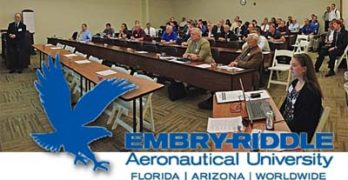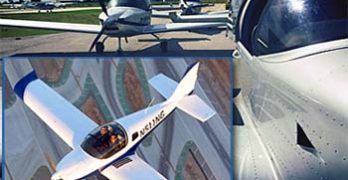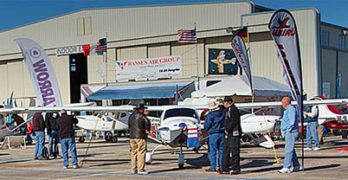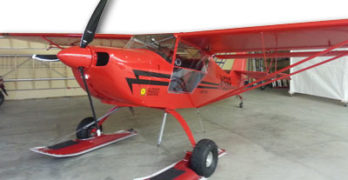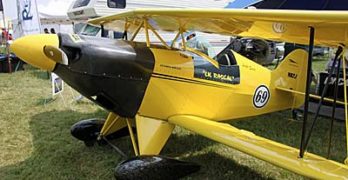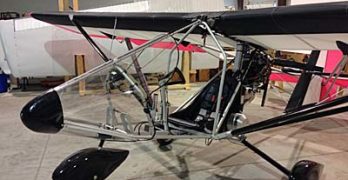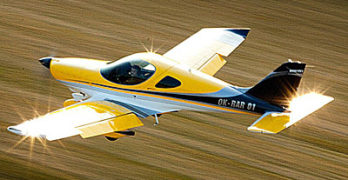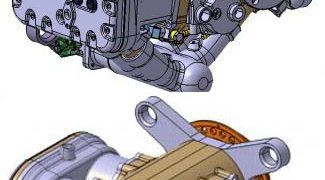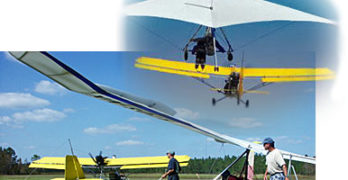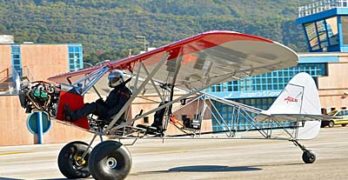Yesterday, filling my role as President of the Light Aircraft Manufacturers Association, I joined Tecnam and Van’s Aircraft as a group of about 100 collegiate educators met in their annual NTAS or National Training Aircraft Symposium. This annual gathering assembled an impressive group of academics who manage flight training for their university students.
It was a day of presentations with a special focus on the ADS-B Out mandate from FAA. For university flight programs operating dozens to hundreds of airplanes each, equipping their certified airplanes represents a major cost. Additionally, maintenance shops qualified to handle this cannot handle a large number of installations if owners wait until the deadline is near. It is estimated that an average of 34 hours of labor is needed per airplane. AEA estimates 105-166,000 U.S. aircraft still need to be equipped in the next five years. It can be done, they said, but not if many owners wait to the last minute to start.
Rotax Awards Free 912 Engine to Flight School
One year ago Rotax announced a contest to award a brand-new 912 engine to the flight school that achieved the first time between overhaul (TBO) of 2,000 hours on a Rotax 912 iS model that the engine builder had just released. Upon reaching the goal, the flight school had to prove the hours by sending a copy of the logbook to their local distributor and then return the used engine to Rotax BRP in Austria.
At the end of January 2015, Rotax announced they had donated a copy of their newest Rotax 912 iS Sport engine to Madiba Bay School of Flight located in Port Elizabeth, Eastern Cape, South Africa. “Madiba Bay achieved the first time between overhauls (TBO) of 2,000 hours on their Sling 2 equipped with a Rotax 912 iS engine,” said representatives of the big Austrian engine manufacturer.
Flight school owner Gerhard Van Eeden said, “We are pleased to be the winner of a brand-new Rotax 912 iS Sport engine.
Four Days of Sebring 2015
Sebring is history, which says the aviation year is now underway. On whole it was a good show and a solid start to 2015. Sebring’s weather was overcast and cool to start though even that didn’t seem to dampen buying enthusiasm. About a dozen airplanes were sold plus numerous vendors reported finding many good prospects. By Friday afternoon the skies went to deep blue and the Sunshine State earned its nickname.
“It was a great Saturday,” wrote U.S. Sport Aviation Expo organizers. The 11th annual Expo nearly filled the auto parking lot and the transient aircraft parking area was hopping with activity, officials said.
While I write about the good news of Sebring, I want to pay respect to two fallen aviators. Dennis Day and Jason Spinks of the Aero Adventures company lost their lives in an unfortunate accident during the event. I offer my sincerest regret for this loss to their families and to the DeLand Airport business team.
7 Aircraft to Look for at Sebring 2015
We’re off to the races … OK, the race track … OK, we’re off to Sebring, which happens to be alongside the Sebring International Raceway. Yep. It’s January so it’s again time for the Sebring Expo, this time number 11, the 2015 edition of the popular Florida show. I’ll be onsite for the four days, which this year is one day sooner, running Wednesday through Saturday. The plan makes it easier for vendors to stay to the end on Saturday and still have time to get home on Sunday so they can be back in their businesses on Monday.
Every time I head to a show people contact me, including journalists from publications that don’t follow Light-Sport, light kits, ultralights, or light GA as closely as we do). The question is always the same. What new aircraft or products will we see at the show? …Uh, let me think.
Going Off to the Air Races, LSA-Style
At first, it all seemed rather unlikely to me. I refer to the concept of racing LSA.
On the one hand you have a giant company with a global presence putting on the Red Bull Air Races. What a way to sell a caffeinated beverage. It works. It’s very showy. It might even induce some race watchers to take up flying. When the aircraft are not touring the race circuit, they occupy luxurious space in the fanciest hangar on the planet, Red Bull’s Hangar 7 at the Salzburg Airport in Mozart’s former home town in Austria (photo).
On the other hand we have Light-Sport Aircraft, a fairly new sector in aviation, now with one decade of history. Being in the distinctly affordable end of aviation, money does not flow as it does from Red Bull. Yet that does not mean LSA will fail to join in the air race fun.
Is a Four Stroke Part 103 Airplane Possible?
Some people have long believed that Part 103-legal weight shift trikes or single place powered parachutes may be possible but I’ve often heard the pronouncement, “You cannot make a legal three axis Part 103 airplane.” I wonder if those folks are ready to admit their error?
Those attending the 2015 Sebring Expo will want to examine the new Aerolite 103 with a Briggs and Stratton four stoke, all freshly mounted and looking better than ever. That you can fly such an airplane without a pilot’s license or medical, without N-number registrations, and buy one ready-to-fly for an affordable price amazes more than a few pilots. However, mostly those machines — a few have been available for some time — use two stroke engines in order to stay within the very confining 254 pounds of empty weight. If you don’t care for two stroke power …Wait no more!
You might remember seeing such a machine at Sun ‘n Fun 2014.
BRM Aero’s Bristell Gains New U.S. Distributor
BRM Aero‘s Bristell got off to a good start in the USA two years ago. Unfortunately, after an initial burst of positive reviews and good response from pilots, the distributor at the time stumbled. A failed association with the now-defunct Aviation Access Project undermined the efforts but that association had nothing to do with the Czech aircraft producer. So, after a year or so of discussions and evaluation, BRM Aero found a new, high-quality representative.
In early December 2014, Bristell Aircraft, a New York corporation, officially accepted the appointment to represent the aircraft of BRM Aero. “Bristell Aircraft is an American company whose roots go deep into the highly-structured world of FAA-certified aircraft,” said Lou Mancuso, director of Bristell Aircraft. Over the last year, Lou has worked directly with BRM Aero “to develop, customize, and standardize aircraft specifically for the North American market.” Lou and his team bring 68 years of aviation sales, service and training success and appear well suited to the endeavor.
Belgium D-Motor Declares ASTM Compliance
In the world of FAA-accepted Light-Sport Aircraft, engines choices have been limited to Rotax, Jabiru, and HKS adding to updated versions from certified engine producers such as Continental and Lycoming plus the big Titan engine from ECi. Now, according to the U.S. importer, that rather exclusive club is joined by Belgium’s D-Motor, while earlier reports suggested the UL Power engine is also pursuing ASTM compliance. “We invested 500 hours testing the LF26 D-Motor from summer to fall,” said Doc’ Bailey of Renegade Light Sport, the importer. ASTM requires 100 hours testing by the airframe manufacturer before the engine can be accepted by FAA for installation on a Special LSA.
Doc’ has been in regular contact with the Light-Sport office of FAA. The agency does not audit powerplants the same way as airframe manufacturers, partly as the airframer must add to the engine builder’s testing, but it does keep track of which components the airframe maker has tested.
Working Aircraft … for the Fun of Flying
In two industry meetings held during 2014, Light-Sport Aircraft manufacturers, organization leaders, FAA personnel, and other interested parties reviewed a list of changes that would improve the 10-year-old SP/LSA regulation. Some items represent minor changes the agency could make fairly quickly. Others are more challenging. Number one on the list involves FAA allowing certain commercial LSA operations when flown by qualified pilots. Even if no great resistance exists — and reasons for optimism are present — this could be some time coming as regulation change is complicated in today’s federal government. Another area of intense interest is electric power. While unleashing development of LSA using electric propulsion also requires regulation change, an exemption might allow technical progress before rule change could occur. Recently another group with many more years of effort already invested was able to earn such an exemption. Ed Pitman of Pitman Air recently announced Exemption 11104.
Ride-On Zlin; New Variation on Theme
Thanks to powerful Cubalike airplanes — those vintage yellow taildraggers types with huge engines up front to make them perform more energetically — 2014 saw increased attention to the Savage Cub S. The Czech company offered their 180-horsepower version of the Cubalike phenomenon albeit at a more affordable price. The leading brand of Cub-like airplanes has pushed prices beyond $200,000, which strikes plenty of people as paying a premium, though most agree the design is handsomely achieved. They continue to sell well so vintage style appears to hold appeal.
Meanwhile, Zlin engineers aren’t sitting still. This company has quite a flock of intriguing models, including Savage Classic, Savage Cruiser, Savage Cub (marketed as iCub in the U.S.), Savage Cub S, and Bobber. All these are now represented in America by SportairUSA, which also imports the TL Ultralight Sting and Sirius as well as selling Searey amphibious kits among a variety of other products of services they’ve assembled.
- « Previous Page
- 1
- …
- 5
- 6
- 7
- 8
- 9
- …
- 52
- Next Page »


